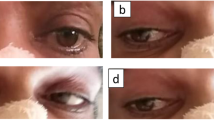Abstract
Lesions affecting the body of the optic chiasm typically produce bitemporal hemianopia. The blood supply comes from the anterior communicating artery, anterior cerebral, posterior communicating, posterior cerebral, and basilar arteries. We herein report a young patient admitted to the emergency department with acute confusion, left-sided hemiparesis, hemihypoesthesia, and dysarthria. Bitemporal hemianopia was detected after resolution of confusion. On cranial magnetic resonance imaging (MRI), infarction in the right anterolateral thalamus in the territory of tuberothalamic artery (TA) and in posterior chiasma in the territory of the posterior communicating artery (PCoA) was revealed. Cerebral MR angiography showed luminal irregularity of the PCoA. The patient was presented to draw attention to the rare entity ischemic chiasmal syndrome.


Similar content being viewed by others
References
Kidd D (2009) The optic chiasm. Clin Anat 27:1149–1158
Foroozan R (2016) Visual findings in chiasmal syndromes. Int Ophthalmol Clin 56:1–27
Blunt MJ, Steele EJ (1956) The blood supply of the optic nerve and chiasma in man. J Anat 90:486–493
Bergland R (1969) The arterial supply of the human optic chiasm. J Neurosurg 31:327–334
Salaud C, Ploteau S, Blery P, Pilet P, Armstrong O, Hamel A (2018) Extrinsic and intrinsic blood supply to the optic chiasm. Clin Anat 31(3):432–440
Kim J, Choi HY, Nam HS, Lee JY, Heo JH (2008) Mechanism of tuberothalamic infarction. Eur J Neurol 15(10):1118–1123
Singhal AB, Biller J, Elkind MS, Fullerton HJ, Jauch EC, Kittner SJ, Levine DA, Levine SR (2013) Recognition and management of stroke in young adults and adolescents. Neurology 81(12):1089–1097
Kissela BM, Khoury JC, Alwell K, Moomaw CJ, Woo D, Adeoye O, Flaherty ML, Khatri P, Ferioli S, De Los Rios La Rosa F, Broderick JP, Kleindorfer DO (2012) Age at stroke: temporal trends in stroke incidence in a large, biracial population. Neurology 79(17):1781–1787
Aigner A, Grittner U, Rolfs A, Norrving B, Siegerink B, Busch MA (2017) Contribution of established stroke risk factors to the burden of stroke in young adults. Stroke 48(7):1744–1751
Cha KC, Kim HT, Kim MH (1990) Two cases of suspected arteriosclerotic optic chiasmal syndrome. J Korean Med Sci 5:169–172
Author information
Authors and Affiliations
Corresponding author
Ethics declarations
Conflict of interest
The authors declare that they have no conflict of interest.
Ethical approval
All procedures performed in studies involving human participants were in accordance with the ethical standards of the institutional and/or national research committee and with the 1964 Helsinki declaration and its later amendments or comparable ethical standards.
Informed consent
Informed consent was obtained from the individual participant included in the case report.
Additional information
Publisher’s note
Springer Nature remains neutral with regard to jurisdictional claims in published maps and institutional affiliations.
Rights and permissions
About this article
Cite this article
Ataç, C., Ak, A.K., Batum, M. et al. Ischemic chiasmal syndrome associated with posterior communicating artery (PCoA) and tuberothalamic artery (TA) infarction: a case report. Neurol Sci 42, 1227–1230 (2021). https://doi.org/10.1007/s10072-020-04906-4
Received:
Accepted:
Published:
Issue Date:
DOI: https://doi.org/10.1007/s10072-020-04906-4




